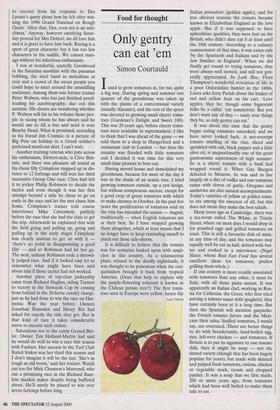Food for thought
Only gentry can eat 'em
Simon Courtauld
Iused to grow tomatoes in, for me, quite a big way. During spring and summer one quarter of the greenhouse was taken up with the plants of a conventional variety (usually Alicante), and the rest of the space was devoted to growing small cherry toma- toes (Gardener's Delight and Sweet 100). This was 20 years ago, before cherry toma- toes were available in supermarkets. I like to think that I was ahead of the game — we sold them to a shop in Hungerford and a restaurant club in London — but then the country was flooded with little tomatoes and I decided it was time for this very small-time pioneer to bow out.
Having moved house and demolished my greenhouse, because for most of the day it was in the shade of an acacia tree, I tried growing tomatoes outside, up a yew hedge, but without conspicuous success, except for a good crop of green tomatoes with which to make chutney in October. In the past few years the proliferation of tomatoes sold on the vine has extended the season — August, traditionally — when English tomatoes are at their best. So I have stopped growing them altogether, which at least means that I no longer have to keep reminding myself to pinch out those side-shoots.
It is difficult to believe that the tomato was for centuries looked upon with suspi- cion in this country. As a solanaceous plant, related to the deadly nightshade, it was thought to be poisonous when the con- quistadors brought it back from tropical America. (Does that help to explain why the purple-flowering solanum is known as the Chilean potato tree?) The first toma- toes seen in Europe were yellow, hence the Italian pomodoro (golden apple), and for less obvious reasons the tomato became known in Elizabethan England as the love apple. But if it was supposed to have aphrodisiac qualities, they were lost on the British, who didn't dare eat it at least until the 18th century. According to a culinary commentator of that time, it was eaten only 'by the Spaniards and Italians and by the Jew families in England'. When we did finally get round to trying tomatoes, they were always well stewed, and still not gen- erally appreciated. In Lark Rise, Flora Thompson's wonderful evocation of life in a poor Oxfordshire hamlet in the 1880s, Laura asks Jerry Parish about the basket of red and yellow fruit on his cart. 'Love apples, they be; though some hignorant folks be a callin"em tommytoes. But you don't want any of they — nasty sour things they be, as only gentry can eat.'
It was about this time that the gentry began eating tomatoes uncooked, and we have never looked back. A not-overripe tomato smelling of the vine, sliced and sprinlded with salt, black pepper and a little olive oil, is unquestionably one of the great gastronomic experiences of high summer. So is a cherry tomato with a basil leaf wrapped round it. When Guy Burgess defected to Moscow, he was said to live largely on a diet of vodka and raw tomatoes eaten with cloves of garlic. Oregano and anchovies are also natural accompaniments. Today's varieties of yellow or golden toma- to are among the sweetest of all, but this does not mean they make the best salads.
Many years ago at Cambridge, there was a tea-room called The Whim, in Trinity Street, where on most days I would drop in for poached eggs and grilled tomatoes on toast. This is still a favourite dish of mine, at any time of day, and the tomatoes may equally well be cut in half, dotted with but- ter and cooked in a microwave. (Nigel Slater, whose Real Fast Food has several excellent ideas for tomatoes, prefers grilling them whole.) If one country is more readily associated with tomatoes than any other, it must be Italy, with all those pasta sauces. It was apparently an Italian chef, working in Rus- sia for Catherine the Great, who first tried serving a tomato sauce with spaghetti; they have certainly been at it a long time. But then the Spanish will mention gazpacho, the French tomates farcies and the Mexi- cans their salsa. Stuffed tomatoes, I would say, are overrated. There are better things to do with breadcrumbs, hard-boiled egg, rice, left-over chicken — and tomatoes. If Britain is to put its signature to one tomato dish, then it might be soup — not the tinned variety (though that has been hugely popular for years), but made with skinned and pulped fresh tomatoes, onions, chicken or vegetable stock, cream and chopped parsley. It was a soup that we first made, 200 or more years ago, from tomatoes which had been well boiled to make them safe to eat.


























































 Previous page
Previous page